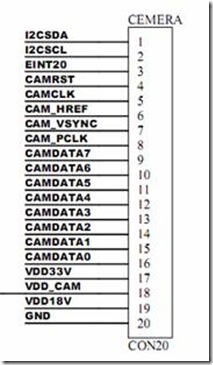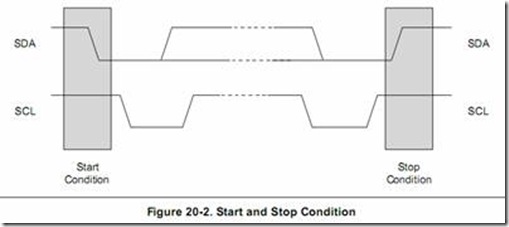driversmediavideos3c2440camif.c
driversmediavideos3c2440_ov9650.c
driversmediavideosccb.c
硬件连接
I2C总线连接


I2CSCL ——GPE14
I2CSDA——GPE15
Sccb.h
#define SIO_C S3C2410_GPE14
#define SIO_D S3C2410_GPE15
#define State(x) s3c2410_gpio_getpin(x)
#define High(x) do{s3c2410_gpio_setpin(x,1); smp_mb();}while(0)
#define Low(x) do{s3c2410_gpio_setpin(x,0); smp_mb();}while(0)
#define WAIT_STABLE() do{udelay(10);}while(0)
#define WAIT_CYCLE() do{udelay(90);}while(0)
#define CFG_READ(x) do{s3c2410_gpio_cfgpin(x,S3C2410_GPIO_INPUT);smp_mb();}while(0)
#define CFG_WRITE(x) do{s3c2410_gpio_cfgpin(x,S3C2410_GPIO_OUTPUT);smp_mb();}while(0)
void sccb_write(u8 IdAddr, u8 SubAddr, u8 data);
u8 sccb_read(u8 IdAddr, u8 SubAddr);
CFG_WRITE(x)把GPIO设置为输出
CFG_READ(x)把GPIO设置为输入
High(x) 把GPIO设置为高电平
Low(x) 把GPIO设置为低电平
Sccb.c

把SCL和Data都拉高,即为默认初始化状态电平
int sccb_init(void)
{
CFG_WRITE(SIO_C);
CFG_WRITE(SIO_D);
High(SIO_C);
High(SIO_D);
WAIT_STABLE();
return 0;
}
由上面的图可以看出,CLK高电平时,DATA拉低,即为START
static void __inline__ sccb_start(void)
{
CFG_WRITE(SIO_D);
Low(SIO_D);
WAIT_STABLE();
}
使用到一个信号量
static DECLARE_MUTEX(bus_lock);
void sccb_write(u8 IdAddr, u8 SubAddr, u8 data)
{
down(&bus_lock);
sccb_start();
sccb_write_byte(IdAddr);
sccb_write_byte(SubAddr);
sccb_write_byte(data);
sccb_stop();
up (&bus_lock);
}
首先把信号量数值降低,表示自己使用,如果此时信号量不大于0,表示bus正在使用,驱动会在此等待,知道信号量大于0,然后,将其减1,此时bus对外界不可用。最后再把信号量加1,表示bus可用。
%%%%%%%%%%%%%%%%%%%%%%%%%%%%%%%%%%%%%%%%%
摄像头接口初始化:
/*
* camif_init()
*/
static int __init camif_init(void)
{
配置CAMIF的GPIO接口功能
/* set gpio-j to camera mode. */
s3c2410_gpio_cfgpin(S3C2440_GPJ0, S3C2440_GPJ0_CAMDATA0);
s3c2410_gpio_cfgpin(S3C2440_GPJ1, S3C2440_GPJ1_CAMDATA1);
s3c2410_gpio_cfgpin(S3C2440_GPJ2, S3C2440_GPJ2_CAMDATA2);
s3c2410_gpio_cfgpin(S3C2440_GPJ3, S3C2440_GPJ3_CAMDATA3);
s3c2410_gpio_cfgpin(S3C2440_GPJ4, S3C2440_GPJ4_CAMDATA4);
s3c2410_gpio_cfgpin(S3C2440_GPJ5, S3C2440_GPJ5_CAMDATA5);
s3c2410_gpio_cfgpin(S3C2440_GPJ6, S3C2440_GPJ6_CAMDATA6);
s3c2410_gpio_cfgpin(S3C2440_GPJ7, S3C2440_GPJ7_CAMDATA7);
s3c2410_gpio_cfgpin(S3C2440_GPJ8, S3C2440_GPJ8_CAMPCLK);
s3c2410_gpio_cfgpin(S3C2440_GPJ9, S3C2440_GPJ9_CAMVSYNC);
s3c2410_gpio_cfgpin(S3C2440_GPJ10, S3C2440_GPJ10_CAMHREF);
s3c2410_gpio_cfgpin(S3C2440_GPJ11, S3C2440_GPJ11_CAMCLKOUT);
s3c2410_gpio_cfgpin(S3C2440_GPJ12, S3C2440_GPJ12_CAMRESET);
申请CAMIF的寄存器区域,由于OS的系统统一管理,所以,需要确定,该寄存器区域没有被别的进程获取,所以要申请。
/* init camera's virtual memory. */
if (!request_mem_region((unsigned long)S3C2440_PA_CAMIF, S3C2440_SZ_CAMIF, CARD_NAME))
{
ret = -EBUSY;
goto error1;
}
申请到了寄存器区域,相当于物理地址可用,然后,再将该物理地址映射到虚拟地址。
/* remap the virtual memory. */
camif_base_addr = (unsigned long)ioremap_nocache((unsigned long)S3C2440_PA_CAMIF, S3C2440_SZ_CAMIF);
if (camif_base_addr == (unsigned long)NULL)
{
ret = -EBUSY;
goto error2;
}
获取CAMIF的时钟,使用24M
/* init camera clock. */
pdev->clk = clk_get(NULL, "camif");
if (IS_ERR(pdev->clk))
{
ret = -ENOENT;
goto error3;
}
clk_enable(pdev->clk);
camif_upll_clk = clk_get(NULL, "camif-upll");
clk_set_rate(camif_upll_clk, 24000000);
mdelay(100);
初始化CAMIF的状态
/* init camif state and its lock. */
pdev->state = CAMIF_STATE_FREE;
CAMIF DEV的状态:
/* for s3c2440camif_dev->state field. */
enum
{
CAMIF_STATE_FREE = 0, // not openned
CAMIF_STATE_READY = 1, // openned, but standby
CAMIF_STATE_PREVIEWING = 2, // in previewing
CAMIF_STATE_CODECING = 3 // in capturing
};
注册杂项设备:
/* register to videodev layer. */
if (misc_register(&misc) < 0)
{
ret = -EBUSY;
goto error4;
}
printk(KERN_ALERT"s3c2440 camif init donen");
初始化SCCB接口,Serial Camera Control Bus,其实是I2C接口
sccb_init();
硬件复位CAMIF
hw_reset_camif();
其实是软件复位,对CIGCTRL寄存器配置软件复位
/* software reset camera interface. */
static void __inline__ hw_reset_camif(void)
{
u32 cigctrl;
cigctrl = (1<<30)|(1<<29);
iowrite32(cigctrl, S3C244X_CIGCTRL);
mdelay(10);
cigctrl = (1<<29);
iowrite32(cigctrl, S3C244X_CIGCTRL);
mdelay(10);
}

检测是否存在OV9650,GPG4连的是LCD_PWR,不知道为什么?
has_ov9650 = s3c2440_ov9650_init() >= 0;
s3c2410_gpio_setpin(S3C2410_GPG4, 1);

OV9650的初始化:
int s3c2440_ov9650_init(void)
{
printk(KERN_ALERT"Loading OV9650 driver.........n");
/* power on. */
ov9650_poweron();
mdelay(100);
/* check device. */
if (ov9650_check() == 0 && ov9650_check() == 0)
{
printk(KERN_ERR"No OV9650 found!!!n");
return -ENODEV;
}
show_ov9650_product_id();
ov9650_init_regs();
printk("ov9650 init done!n");
return 0;
}
OV9650上电,这里对GPG12设置为输出,这里使用的虽然是中断引脚,但似乎没有用中断,这是一个电源控制引脚,PWDN,0:power on,1:power down
static void __inline__ ov9650_poweron(void)
{
s3c2410_gpio_cfgpin(S3C2410_GPG12, S3C2410_GPG12_OUTP);
s3c2410_gpio_setpin(S3C2410_GPG12, 0);
mdelay(20);
}


OV9650检测,读取OV9650的Manu ID
static int __inline__ ov9650_check(void)
{
u32 mid;
mid = sccb_read(OV9650_SCCB_ADDR, 0x1c)<<8;
mid |= sccb_read(OV9650_SCCB_ADDR, 0x1d);
printk("SCCB address 0x%02X, manufacture ID 0x%04X, expect 0x%04Xn", OV9650_SCCB_ADDR, mid, OV9650_MANUFACT_ID);
return (mid==OV9650_MANUFACT_ID)?1:0;
}
#define OV9650_SCCB_ADDR 0x60
#define OV9650_MANUFACT_ID 0x7FA2
#define OV9650_PRODUCT_ID 0x9650
%%%%%%%%%%%%%%%%%%%%%%%%%%%%%%%%%%%%%%%%%
摄像头接口打开:
/*
* camif_open()
*/
static int camif_open(struct inode *inode, struct file *file)
{
首先判断是否存在OV9650 camera是文件开始的一个static变量。
struct s3c2440camif_dev *pdev;
struct s3c2440camif_fh *fh;
int ret;
if (!has_ov9650) {
return -ENODEV;
}
pdev = &camera;
为file handle分配内存
fh = kzalloc(sizeof(*fh),GFP_KERNEL); // alloc memory for filehandle
设置设备状态为open and standby,初始化CAMIF的配置。
pdev->state = CAMIF_STATE_READY;
init_camif_config(fh);
对CAMIF进行配置,最后更新一下配置
/* config camif when master-open camera.*/
static void init_camif_config(struct s3c2440camif_fh * fh)
{
struct s3c2440camif_dev * pdev;
pdev = fh->dev;
pdev->input = 0; // FIXME, the default input image format, see inputs[] for detail.
/* the source image size (input from external camera). */
pdev->srcHsize = 1280; // FIXME, the OV9650's horizontal output pixels.
pdev->srcVsize = 1024; // FIXME, the OV9650's verical output pixels.
/* the windowed image size. */
pdev->wndHsize = 1280;
pdev->wndVsize = 1024;
/* codec-path target(output) image size. */
pdev->coTargetHsize = pdev->wndHsize;
pdev->coTargetVsize = pdev->wndVsize;
/* preview-path target(preview) image size. */
pdev->preTargetHsize = 640;
pdev->preTargetVsize = 512;
update_camif_config(fh, CAMIF_CMD_STOP);
}
由于设备状态是CAMIF_STATE_READY所以,直接更新寄存器。
/* update camera interface with the new config. */
static void update_camif_config (struct s3c2440camif_fh * fh, u32 cmdcode)
{
struct s3c2440camif_dev * pdev;
pdev = fh->dev;
switch (pdev->state)
{
case CAMIF_STATE_READY:
update_camif_regs(fh->dev); // config the regs directly.
break;
case CAMIF_STATE_PREVIEWING:
/* camif is previewing image. */
disable_irq(IRQ_S3C2440_CAM_P); // disable cam-preview irq.
/* source image format. */
if (cmdcode & CAMIF_CMD_SFMT)
{
// ignore it, nothing to do now.
}
/* target image format. */
if (cmdcode & CAMIF_CMD_TFMT)
{
/* change target image format only. */
pdev->cmdcode |= CAMIF_CMD_TFMT;
}
不知为什么要等待VSYNC为L?然后对寄存器进行配置。
/* update camif registers, called only when camif ready, or ISR. */
static void __inline__ update_camif_regs(struct s3c2440camif_dev * pdev)
{
if (!in_irq())
{
while(1) // wait until VSYNC is 'L'
{
barrier();
if ((ioread32(S3C244X_CICOSTATUS)&(1<<28)) == 0)
break;
}
}
/* WARNING: don't change the statement sort below!!! */
update_source_fmt_regs(pdev);
update_target_wnd_regs(pdev);
update_target_fmt_regs(pdev);
update_target_zoom_regs(pdev);
}
初始化CAMIF的DMA内存。
ret = init_image_buffer(); // init image buffer.
这里为DMA分配内存,按页分配,内存管理的知识需要学习?
/* init image buffer (only when the camif is first open). */
static int __inline__ init_image_buffer(void)
{
int size1, size2;
unsigned long size;
unsigned int order;
/* size1 is the max image size of codec path. */
size1 = MAX_C_WIDTH * MAX_C_HEIGHT * 16 / 8;
/* size2 is the max image size of preview path. */
size2 = MAX_P_WIDTH * MAX_P_HEIGHT * 16 / 8;
size = (size1 > size2)?size1:size2;
order = get_order(size); //获取需要分配字节的2的阶数,内存按页分配
img_buff[0].order = order;
img_buff[0].virt_base = __get_free_pages(GFP_KERNEL|GFP_DMA, img_buff[0].order);
if (img_buff[0].virt_base == (unsigned long)NULL)
{
goto error0;
}
img_buff[0].phy_base = img_buff[0].virt_base - PAGE_OFFSET + PHYS_OFFSET; // the DMA address.
申请中断,分别为Codec的中断和Preview的中断
request_irq(IRQ_S3C2440_CAM_C, on_camif_irq_c, IRQF_DISABLED, "CAM_C", pdev);
request_irq(IRQ_S3C2440_CAM_P, on_camif_irq_p, IRQF_DISABLED, "CAM_P", pdev);
使能时钟,软件复位,更新CAMIF的配置。
clk_enable(pdev->clk); // and enable camif clock.
soft_reset_camif();
file->private_data = fh;
fh->dev = pdev;
update_camif_config(fh, 0);
%%%%%%%%%%%%%%%%%%%%%%%%%%%%%%%%%%%%%%%%%
摄像头接口读取函数:
static ssize_t camif_read(struct file *file, char __user *data, size_t count, loff_t *ppos)
{
int i;
struct s3c2440camif_fh * fh;
struct s3c2440camif_dev * pdev;
fh = file->private_data;
pdev = fh->dev;
if (start_capture(pdev, 0) != 0) //此处是捕获一张图片,所以会阻塞在此,直至中断发生。
{
return -ERESTARTSYS;
}
//中断已经发生,数据已经更新。
disable_irq(IRQ_S3C2440_CAM_C);
disable_irq(IRQ_S3C2440_CAM_P);
for (i = 0; i < 4; i++)
{
if (img_buff[i].state != CAMIF_BUFF_INVALID) //如果数据已经更新,移动数据
{
copy_to_user(data, (void *)img_buff[i].virt_base, count);
img_buff[i].state = CAMIF_BUFF_INVALID; //设置数据无效
}
}
enable_irq(IRQ_S3C2440_CAM_P); //重新使能中断
enable_irq(IRQ_S3C2440_CAM_C);
return count;
}
开始捕获函数,设置window offset
/* start image capture.
*
* param 'stream' means capture pictures streamly or capture only one picture.
*/
static int start_capture(struct s3c2440camif_dev * pdev, int stream)
{
int ret;
u32 ciwdofst;
u32 ciprscctrl;
u32 ciimgcpt;
ciwdofst = ioread32(S3C244X_CIWDOFST); //window offset
ciwdofst |= (1<<30) // Clear the overflow indication flag of input CODEC FIFO Y
|(1<<15) // Clear the overflow indication flag of input CODEC FIFO Cb
|(1<<14) // Clear the overflow indication flag of input CODEC FIFO Cr
|(1<<13) // Clear the overflow indication flag of input PREVIEW FIFO Cb
|(1<<12); // Clear the overflow indication flag of input PREVIEW FIFO Cr
iowrite32(ciwdofst, S3C244X_CIWDOFST);
ciprscctrl = ioread32(S3C244X_CIPRSCCTRL); //Preview main scale control开始prev
